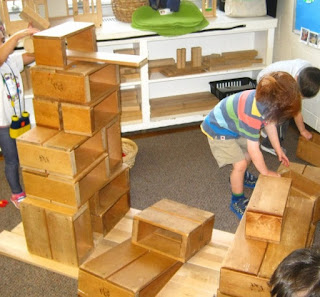When my son was four, he loved preschool. One of his
only complaints was that he hardly ever got to play with the big blocks. His
classroom had a long wall lined with hollow blocks (aka “big blocks”) but that
area was only occasionally open for play. “What did you do at school today?” I
would ask. Sometimes he would say, “The big blocks were open today!” followed
by an excited description of what he had built. But much more often, his first
words about his day would be, “The big blocks were closed.”
Hollow blocks are a preschool classroom staple, either
in their own area, or combined with unit blocks. But often, teachers discourage
or ban their use. Teachers sometimes say that the play gets too out of control.
Or that the kids argue too much while building. Or that the themes that children
use are too violent, scary, or wild. Or that blocks aren’t safe, because they
might fall on someone. When children are allowed to play with big blocks, it’s
often with a lengthy set of limits and rules: how many children can play at a
time, restrictions on what can be built, and limits on the height or size of a
structure.
Why are teachers so scared of big blocks?
Yes, the play can get active. But, just like any other
activity, whether it gets “out of control” depends on teacher guidance, interaction,
and support. Yes, children will argue about what to build and how to build it,
but that social interaction should be a goal, not something to avoid. Negotiation
about planning, ideas, themes, and roles are crucial social skills that
children learn by doing. Eliminating settings for this negotiation might
prevent social conflict, but it also eliminates opportunities for children to practice
and improve these skills.
Children are drawn to the big blocks simply because
they are big blocks. It takes work to move them – challenging, physical work.
Children are drawn to the scale of the big blocks because they can make structures
that are their own size and that they can fit on, in, and under. They are
captivated by concepts of height and risk. The concern that a block could fall
on someone’s head might be expressed as fear by the teacher, but for the child,
that concern is turned into a challenge of how to prevent it from happening.
Figuring out how to build a strong, stable structure, nearly as big as or even
bigger than their own bodies, gives children a chance to express competency,
confidence, and skill. It involves imagination, creativity, engineering, and
design, all in the context of social interaction, as a group – sometimes a
large group – of children discuss, debate, argue, and negotiate about their
ideas.
Yes, the big blocks can be risky. And loud. And wild.
But they can also be imaginative, inspiring, thought-provoking, and
cooperative. They can be the place in the classroom where rich, collaborative,
social play happens. They can be the place where children propose and test
ideas and evaluate their results. They
can be the place where children learn how to disagree and discuss differences
of opinion. They can be the place where children test their limits and
abilities, and push themselves to see what they can accomplish. And we, the
teachers, can stand beside them and support them each step of the way.







No comments:
Post a Comment